In the world of birds, there are some incredible species that have found a unique place to build their nests – right among the rocks! These resourceful birds have discovered the benefit of raising their young in the rugged and unforgiving landscape of rocky habitats – it prevents many predators from reaching them.
Examples of birds that lay eggs in rocks include killdeer, razorbills, Atlantic puffins, Cape petrels, and many others.
Here’s what each of their eggs looks like.
Table of Contents
Birds That Nest In Rocks
1. Killdeer
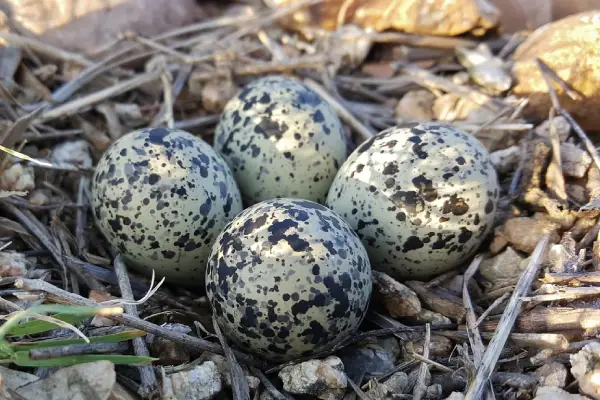

Killdeers are big plovers found in North, Central, and South America. They nest on the ground in open areas, building shallow scrapes in soil or gravel that they occasionally outline with pebbles, grass, twigs, and debris.
Killdeers lay from 4 to 6 buff-colored eggs that are heavily marked with dark brown markings. Such an egg appearance allows it to blend well with the surroundings.
Their breeding season lasts from March to August and both parents will take turns in incubating the eggs. Their pear-shaped eggs are around 1.5 inches long and 1.1 inches wide – parents incubate them from 22 to 28 days.
Unfortunately, almost half of the eggs killdeer lay will not hatch, mostly due to predators (gulls, crows, raccoons, skunks) and parasitic birds.
2. Common Murre
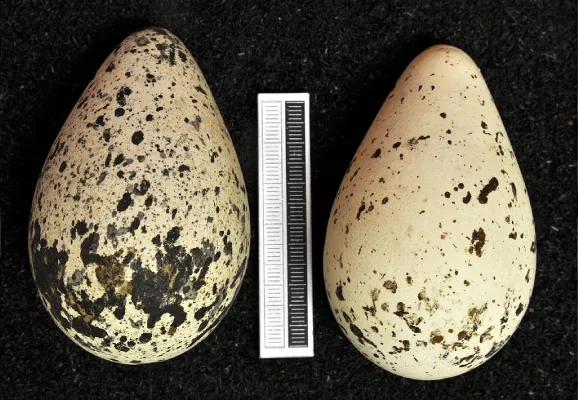
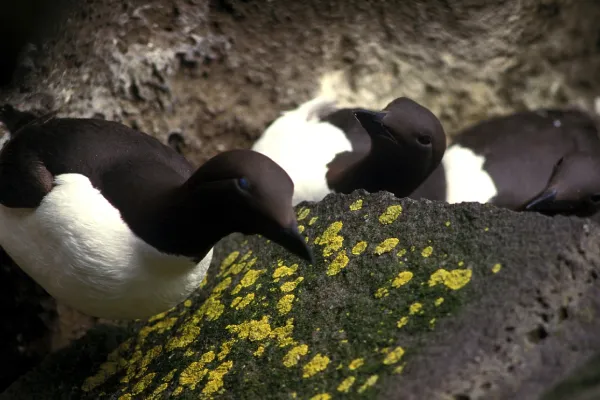
Common murres are large black-and-white seabirds found on the Pacific Coast from Alaska to California and in Eastern Canada.
Despite their nickname “flying penguins,” they are related to auks and puffins. These birds spend most of their time at sea and only come to land to breed on rocky cliffs or islands.
Common mures do not build nests and lay 1 egg directly on rock ledges, hidden crevices, or under a boulder. The egg is pointy on one end and varies in color from white, green, or blue with brown, reddish, and black markings.
The Atlantic populations lay eggs from May to July while those in the Pacific do that from March to July. Both parents will incubate the eggs for 28-37 days and feed the chick after hatching.
Unfortunately, common murres might lose their eggs due to predation (by crows and gulls) or carelessness (knocking them off from ledges during flights) – they live in such densely packed colonies with adults touching other adults while incubating their eggs.
3. Razorbill


Razorbills, also known as razor-billed auks and lesser auks, are the northern hemisphere’s ecological equivalents of penguins. In North America, they breed in colonies on rocky islands, along the coasts of eastern Canada, and in a few spots in Maine.
The species is monogamous and pairs mate for life. They nest in crevices in cliffs, under boulders, on ledges, or in abandoned burrows of other species – occasionally they might not even build the nest but make a small collection of pebbles and grass.
Razorbills lay one cream-colored egg with brown spots that both parents take turns incubating. The egg has an ovoid-pyramidal shape.
After 32-39 days, the chick will hatch and both parents will continue feeding it. The main predators of their eggs are gulls and ravens.
4. Northern Gannet
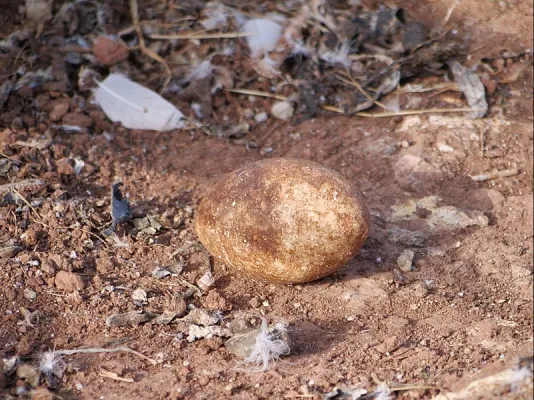

Northern gannets are the largest species of the gannet family native to the coasts of the Atlantic Ocean. They breed in Northeastern North America and Western Europe, nesting in enormous colonies on rocky cliffs, sometimes on the ground or slopes.
Most of their nests are on windward sides of a headland with constant updrafts to help them take off and land. Males usually build the nests using some grass, seaweed, dirt, feathers, and droppings.
Northern gannets lay a single egg that is pale blue and greenish, before fading to a chalky white surface that is easily stained. The egg measures around 3.2 inches in length and 2 inches in width and weighs 3.6 ounces.
In case you see a nest with 2 eggs, that usually means that 2 females laid an egg in the same nest or they stole one from another nest. Both parents incubate the egg(s), for 42-46 days.
Main egg predators include birds (common ravens, great black-backed gulls, American herring gulls), ermines, and red foxes – if they lose one, northern gannets will lay a replacement egg.
5. Least Tern


Least terns are small tern species that breed in North America and northern parts of South America. There are 3 subspecies found in the USA:
- S. a. athalassos – breeds on the Arkansas River, Mississippi River, Brazos River, Trinity River, and Rio Grande basins
- S. a. antillarum – breeds on the Atlantic coast, ranging from Maine to the east and south coasts of the USA
- S. a. browni – breeds on the Pacific coast, ranging from central California south to western parts of Mexico
These terns nest in colonies on beaches or islands on coastlines and rivers. They build their nests on the ground in a shallow scrape they occasionally line with pebbles, grass, and debris.
On occasion, least terns might nest in gravel pits, dredge spoil sites, level gravel rooftops, or arid mudflats. Females will choose the nesting sites and their nests are about 4 inches in diameter and less than an inch deep.
Least terns lay 1-3 pale green eggs with black, brown, and gray splotches. Egg length varies from 0.9 to 1.4 inches and 0.8 to 1 inch in width.
Both parents incubate the eggs and if the weather gets too hot, they will dip themselves in water and then cool the eggs with their wet belly feathers. Incubation lasts 19-25 days and the chicks hatch with their eyes open and the ability to walk.
They will stay in their nests for a few days and find places to hide nearby. Both parents will feed them and the chicks make their first flights after 19-20 days. Least terns usually raise 1 brood per year but might attempt 2 in the south. They are monogamous and often stay together for several years.
Read More: Common North American birds that lay green eggs
6. Northern Fulmar
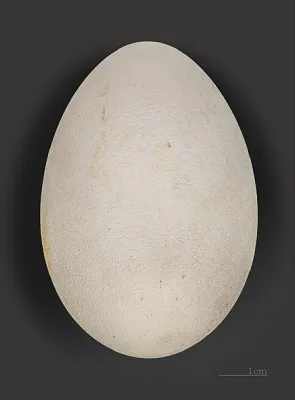
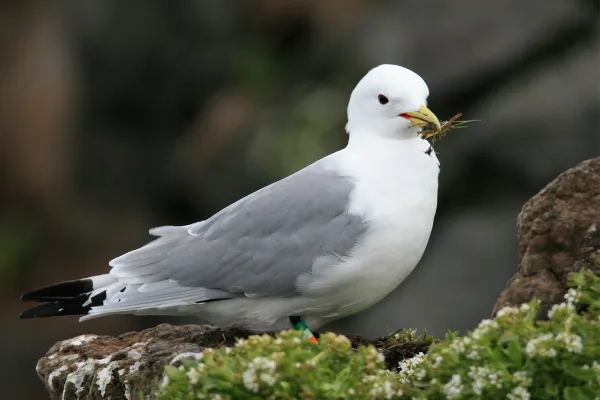
Although they look like gulls, these gray-and-white birds with nostril tubes on their bills are actually related to petrels and albatrosses. In North America, northern fulmars breed mainly in high Arctic Canada and on islands in the Bering Sea.
They usually nest on rocky and grassy cliffs, using depressions in rocks, sand, or soil that they line with a few pebbles and grass. Northern fulmars lay 1 white egg that measures 2.9 inches long and 2 inches wide.
Both parents incubate it for 50-54 days and later feed the chick, by regurgitation.
7. Atlantic Puffin


Atlantic puffins, also known as common puffins, are small diving seabirds native to the Atlantic Ocean. These black birds with white bellies have rather unique beaks – when viewed from the front, beaks tend to be quite narrow, but when viewed from the side, they are broad and triangular.
They nest in burrows, in natural crevices, or under rocks, and start egg-laying around April.
Atlantic puffins lay 1 dull white egg that is around 2.4 inches long and 1.8 inches wide and 2.18 oz heavy. The egg they lay in rocks might sometimes be faintly marked with brown.
Although both parents incubate the egg for 36-45 days, females might do more work. Both parents will also feed the nestlings, bringing them fish in their bills. Main egg predators include herring gulls and lesser black-backed gulls.
8. Cape Petrel
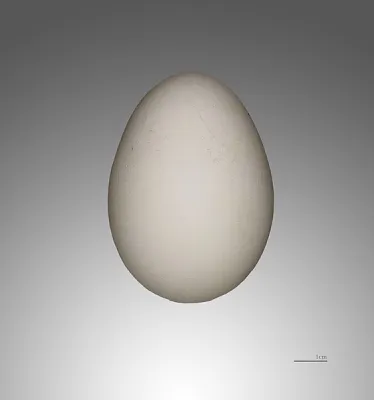
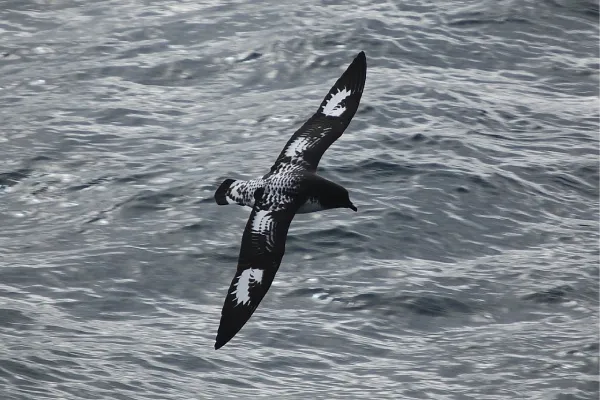
Cape petrels are common seabirds of the Antarctic Ocean. They are known under several names, including Cape pigeons, pintado petrels (painted petrels in Spanish), or Cape fulmars.
These colonial birds will nest on cliffs, placing the nests in rocks and crevices. Cape petrels lay 1 white egg around November that both parents incubate for 45 days. The egg measures around 2.1 inches long and 1.5 inches wide – the main egg predators are skuas.
Read More: Examples of birds laying red speckled eggs
9. European Shag
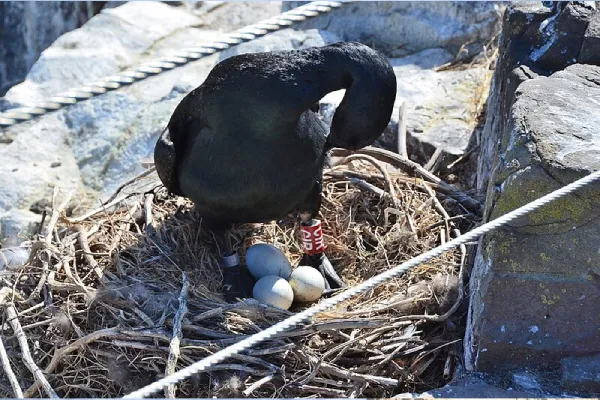
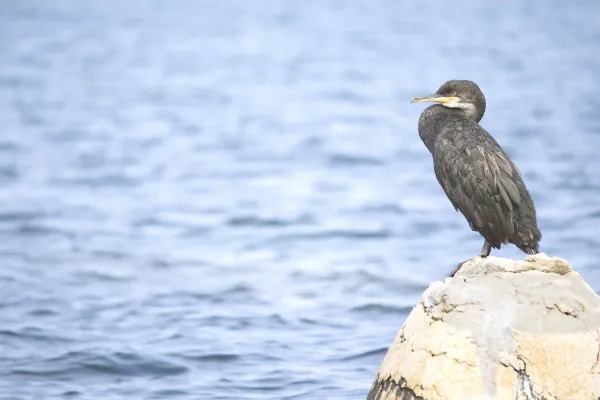
European or common shags are cormorant species found on the rocky coasts of western and southern Europe, southwest Asia, and northern Africa. Part of their scientific name (Gulosus aristotelis) is after the famous Greek philosopher Aristotle.
European shags breed on coasts and nest in crevices, small caves, or rocky ledges – females will lay 3 pale blue eggs with markings.
10. Red-billed Tropicbird

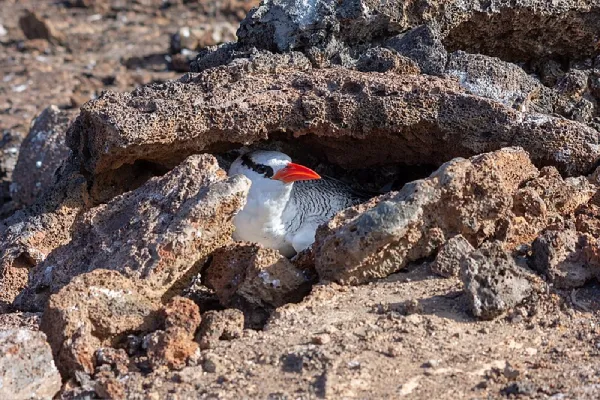
Red-billed tropicbirds are seabirds of tropical oceans that resemble terns. They are mostly white with some black markings on the wings and back, and red bills.
These birds are widespread across the Atlantic, Pacific, and Indian Oceans – in North America can be occasionally seen off the California coast.
They nest in loose colonies in a hole or in a crevice, on the bare ground. Females lay a single egg that both parents incubate. The egg is white-purple with reddish-brown spots and weighs around 2.4 oz. Both parents incubate it for 42-46 days – the main predators include rats.
Summary
Birds are incredible creatures that have found extraordinary ways to adapt to their environments and ensure the survival of their offspring. Some species use a special strategy to protect their precious eggs in harsh and unforgiving landscapes – by nesting among rocks!
Some of the most common birds that lay eggs in rocks include common murres, killdeers, least terns, Cape petrels, and others.
If you enjoyed this article, feel free to check out our ID guide on white and brown bird eggs and ID guide on red-colored bird eggs.